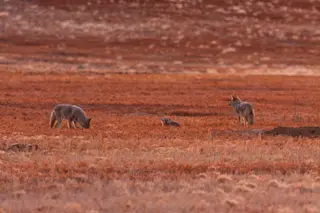In 2020, researchers caught something strange — and stunningly cute — on camera. In the dead of night in the southern Santa Cruz Mountains, a coyote and a badger sauntered out of a wildlife tunnel. The two ambled around then turned around, bumbling back toward the tunnel, but not before showing off the strength of their bond. As the coyote waited for the badger, it bowed its body and wagged its tail, almost as if it was inviting the badger to play.
Seeing a coyote and a badger together in the wild isn't wholly surprising. The species travel together all the time, researchers say, with the combination of the coyote's chasing power and the badger's digging prowess making it much simpler for the two to make meals of squirrels and other burrowing critters. But the video is still something special, showing off the strength of these creatures as a team. Of course, the coyote and the badger are not alone.
What Is a Symbiotic Relationship?
In the world of nature, many species are bonded together. Also known as symbiosis, these bonds are arranged in a variety of ways and are integral to the survival of one or both of the species involved.
What Is Mutualism?
Mutualism is a type of symbiotic relationship between two different species in which both species benefit from the association.
What Is Commensalism?
While mutualism brings benefits to both species, commensalism brings benefits to one species while the other is neither helped nor harmed.
So, with that in mind, what other species maintain these important symbiotic relationships, beyond the frisky coyote and friendly badger?
Read More: 6 Animals With Unusual Evolutionary Traits
1. Coral and Algae
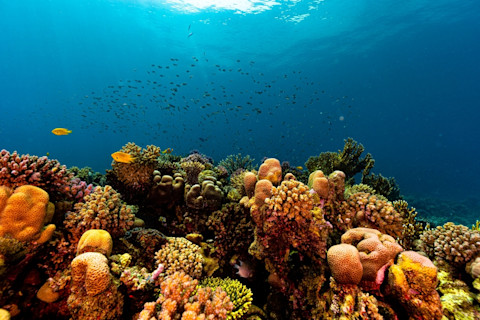
In the Red Sea, and around the world, coral and algae survive in a mutually beneficial balance. While coral provides algae with shelter, algae are a source of nutrition and energy for colorful coral. (Credit: Divetime/Shutterstock)
Divetime/Shutterstock
Coral and algae are so closely bonded that we tend to think of the duo as a single being. But algae actually live inside coral.
Coral and Algae Mutualism
In exchange for a home, the algae nourish the coral with nutrients and energy, allowing the coral to grow its skeleton. This bond began more than 210 million years ago, according to a study by scientists at Princeton University, and some species of coral are so dependent on it that they need algae in order to survive.
Does Ocean Temperature Affect Coral Reefs and Algae?
Unfortunately for both the algae and coral, however, this partnership is highly sensitive to external pressures such as ocean temperatures. Increases of around 1 to 2 degrees Celsius can cause algae to be expelled from its coral home, potentially leading to a process known as "coral bleaching." Once this occurs, previously luminous and brightly colored coral becomes a deathly white.
2. Clownfish and Sea Anemones
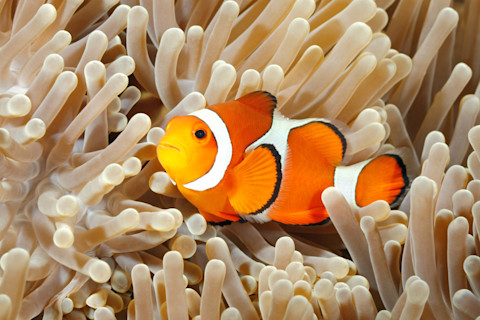
Tucked into the tentacles of an anemone, this clownfish, swimming off the coast of Bali in Indonesia, is a symbol of symbiosis. (Credit: cbpix/Shutterstock)
cbpix/Shutterstock
Another mutual and long-lasting relationship — the relationship between clownfish and sea anemones — is immortalized on the big screen, and for good reason.
Why Do Sea Anemones Not Sting Clownfish?
Anemones pack a sting, but the tiny clownfish isn’t affected thanks to a layer of mucus that protects its skin. In return for the safety of a home, the clownfish wards off potential predators, such as butterfly fish. It also cleanses anemones of parasites, fertilizes them with poop, and helps them breathe at night, according to research.
How Do Clownfish Fit Inside Anemones?
A 2022 study revealed that clownfish adjust their growth size to make sure they fit just right within their anemone abodes. "Large fish are always on large anemones. And our experiment shows that is not a coincidence," Theresa Rueger, a lecturer in Tropical Marine Biology at Newcastle University, said in a statement about the research. "The fish actively regulate their growth to fit their anemone host."
Read More: How Do Animals Evolve to Be So Colorful?
3. Wall Lizards and Arum Lilies
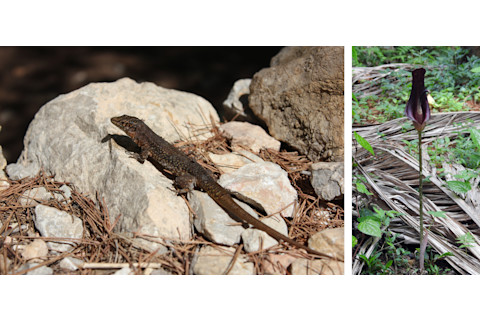
The Lilford's wall lizard savors the smell and the seeds of the dead horse arum lily in the Balearic Islands off of Spain, while the lily travels (and spreads) through the lizard's digestive tract. (Credit: Roman Senko/Shutterstock and Shivram/Shutterstock)
Roman Senko/Shutterstock and Shivram/Shutterstock
Forming an alliance with a plant that smells of rotting flesh may sound unappealing, but that’s exactly what the Lilford's wall lizard does.
The Complex Mutualism Between Wall Lizards and Arum Lilies
In Spain’s Balearic Islands, this small wall lizard picks off insects that are attracted to the stench of the dead horse arum lily, a pungent, purple species of pitcher plant. The interaction doesn’t end there, as the lizards also feast on the plant’s seeds.
Once the seeds pass through the reptile’s digestive system, researchers found that they were more likely to germinate. Thus the lizard snags a meal and unwittingly helps the putrid-smelling plant spread. Other pitcher plants form equally beneficial alliances with a range of species such as bats and shrews.
4. Warthogs and Mongooses
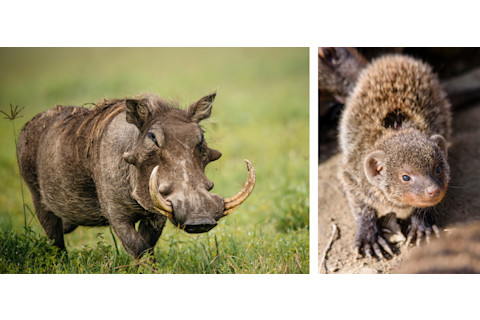
In Africa, itchy, insect-infected warthogs are a buffet for banded mongooses. (Credit: Costas Anton Dumitrescu/Shutterstock and Milan Vachal/Shutterstock).
Costas Anton Dumitrescu/Shutterstock and Milan Vachal/Shutterstock
We all need friends to scratch our itches. And that’s what warthogs in Uganda’s Queen Elizabeth National Park have learned, as they rely on banded mongooses for a special cleaning service.
What Animals Clean a Warthog?
Researchers have observed that the wild pigs lie down when mongooses are around, allowing themselves to be plucked and pruned of any ticks or other parasites. Some adventurously hungry mongooses even clamber on top of the infested pigs to feast.
Such a sanitation service is also provided by the oxpecker, a small bird native to Africa which is also known as the "tickbird," as it munches on pests inhabiting animals like zebras and rhinos. But the birds don't just clean up their mammal friends. They also raise the alarm when danger is nearby, with one study showing that squawking oxpeckers help rhinos avoid nearby humans.
Read More: How Animals Follow their Nose
5. Honeyguide Birds and Humans
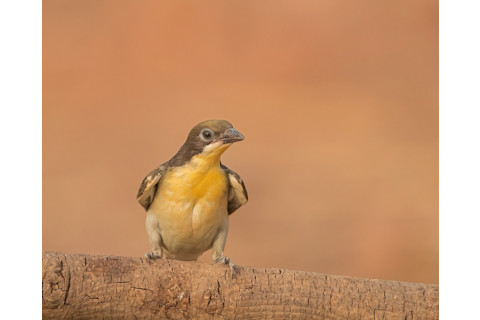
Hungry honeyguide birds are a boon for honey hunters in Tanzania. After finding their sticky, sweet treasure in the trees, the human hunters leave beeswax and larvae as a feast for birds. (Credit: Pascal De Munck/Shutterstock)
Pascal De Munck/Shutterstock
Though rare, some wild species also form alliances with humans, such as the honeyguide bird.
What Bird Leads Humans to Honey?
The honeyguide bird, as its name suggests, charts a path for human honey hunters in northern Tanzania. There, honey hunters follow birds to beehives that hang from the branches of tallest trees. Some honey hunters actually communicate with the birds using special calls, all in an attempt to recruit helpful honeyguides.
What Do Honeyguide Birds Eat?
After leading honey hunters to beehives, the birds are able to feast upon beeswax and larvae, which are left behind by their human accomplices. These birds are also thought to guide honey badgers to nests for a similar purpose, though there is scant evidence of this particular partnership, according to researchers.
6. Ethiopian Wolves and Gelada Monkeys
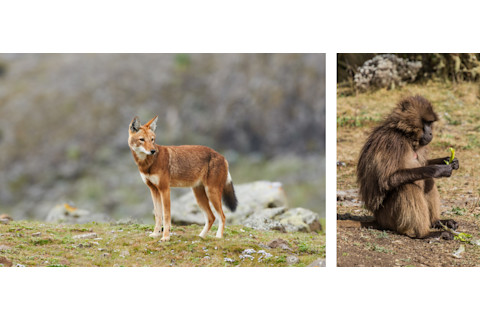
Ethiopian wolves have started hounding herds of Gelada monkeys in the mountains of Ethiopia. Invading the herds helps the wolves hunt rodents, though the benefits for the Geladas aren't abundantly clear. (Credit: ArCaLu/Shutterstock and Matyas Rehak/Shutterstock).
ArCaLu/Shutterstock and Matyas Rehak/Shutterstock
Not all alliances, however, benefit both species. In Ethiopia, for example, researchers have found that critically endangered Ethiopian wolves readily roam through herds of Gelada monkeys, picking off rodents, their main prey.
What Is the Relationship Between Wolves and Monkeys?
The Ethiopian wolves refrain from preying on young geladas, while the geladas allow Ethiopian wolves to move freely within their habitat and among their group, says one study from 2015.
Amongst the monkey herds, the predators tend to be more successful at hunting. But this is not likely to be a case of mutualism, since it is unclear if the monkeys receive anything in return for tolerating the wolves' presence.
Do Geladas Benefit from the Wolves?
It's possible that the wolves are welcomed because their scent deters other potential predators, or because their hunting reduces rodent populations, thereby reducing the competition for grasses that make up the majority of the Gelada diet. But it's also possible that the wolves provide no benefit at all to these incredibly tolerant monkeys, signaling the incredible intricacy of symbiosis when it occurs in the wild.
Read More: How Do Animals Know What Their Predators Are?



